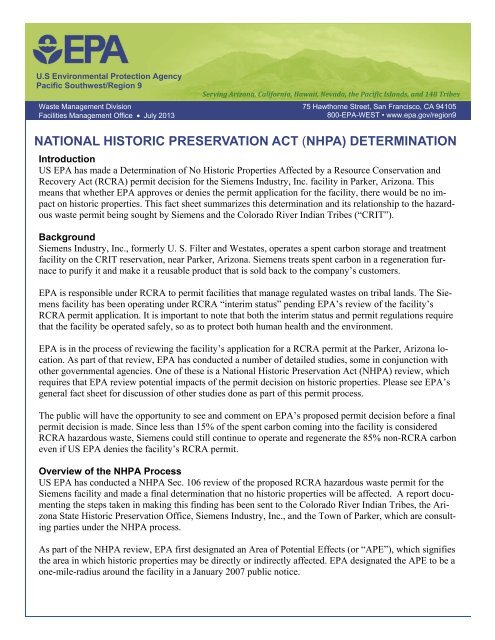Siemens NHPA fact sheet July 2013 - US Environmental Protection ...
Siemens NHPA fact sheet July 2013 - US Environmental Protection ...
Siemens NHPA fact sheet July 2013 - US Environmental Protection ...
You also want an ePaper? Increase the reach of your titles
YUMPU automatically turns print PDFs into web optimized ePapers that Google loves.
U.S <strong>Environmental</strong> <strong>Protection</strong> Agency<br />
Pacific Southwest/Region 9<br />
Waste Waste Management Management Division Division<br />
Facilities Management Office Office June <strong>July</strong> <strong>2013</strong> <strong>2013</strong><br />
Serving Arizona, California, Hawaii, Nevada, the Pacific Islands, and 148 Tribes<br />
75 Hawthorne Street, San Francisco, CA 94105<br />
800-EPA-WEST • www.epa.gov/region9<br />
NATIONAL HISTORIC PRESERVATION ACT (<strong>NHPA</strong>) DETERMINATION<br />
Introduction<br />
<strong>US</strong> EPA has made a Determination of No Historic Properties Affected by a Resource Conservation and<br />
Recovery Act (RCRA) permit decision for the <strong>Siemens</strong> Industry, Inc. facility in Parker, Arizona. This<br />
means that whether EPA approves or denies the permit application for the facility, there would be no impact<br />
on historic properties. This <strong>fact</strong> <strong>sheet</strong> summarizes this determination and its relationship to the hazardous<br />
waste permit being sought by <strong>Siemens</strong> and the Colorado River Indian Tribes (“CRIT”).<br />
Background<br />
<strong>Siemens</strong> Industry, Inc., formerly U. S. Filter and Westates, operates a spent carbon storage and treatment<br />
facility on the CRIT reservation, near Parker, Arizona. <strong>Siemens</strong> treats spent carbon in a regeneration furnace<br />
to purify it and make it a reusable product that is sold back to the company’s customers.<br />
EPA is responsible under RCRA to permit facilities that manage regulated wastes on tribal lands. The <strong>Siemens</strong><br />
facility has been operating under RCRA “interim status” pending EPA’s review of the facility’s<br />
RCRA permit application. It is important to note that both the interim status and permit regulations require<br />
that the facility be operated safely, so as to protect both human health and the environment.<br />
EPA is in the process of reviewing the facility’s application for a RCRA permit at the Parker, Arizona location.<br />
As part of that review, EPA has conducted a number of detailed studies, some in conjunction with<br />
other governmental agencies. One of these is a National Historic Preservation Act (<strong>NHPA</strong>) review, which<br />
requires that EPA review potential impacts of the permit decision on historic properties. Please see EPA’s<br />
general <strong>fact</strong> <strong>sheet</strong> for discussion of other studies done as part of this permit process.<br />
The public will have the opportunity to see and comment on EPA’s proposed permit decision before a final<br />
permit decision is made. Since less than 15% of the spent carbon coming into the facility is considered<br />
RCRA hazardous waste, <strong>Siemens</strong> could still continue to operate and regenerate the 85% non-RCRA carbon<br />
even if <strong>US</strong> EPA denies the facility’s RCRA permit.<br />
Overview of the <strong>NHPA</strong> Process<br />
<strong>US</strong> EPA has conducted a <strong>NHPA</strong> Sec. 106 review of the proposed RCRA hazardous waste permit for the<br />
<strong>Siemens</strong> facility and made a final determination that no historic properties will be affected. A report documenting<br />
the steps taken in making this finding has been sent to the Colorado River Indian Tribes, the Arizona<br />
State Historic Preservation Office, <strong>Siemens</strong> Industry, Inc., and the Town of Parker, which are consulting<br />
parties under the <strong>NHPA</strong> process.<br />
As part of the <strong>NHPA</strong> review, EPA first designated an Area of Potential Effects (or “APE”), which signifies<br />
the area in which historic properties may be directly or indirectly affected. EPA designated the APE to be a<br />
one-mile-radius around the facility in a January 2007 public notice.
Search for Historic Properties<br />
EPA has taken a number of steps to identify historic properties within the APE. First, with assistance from the CRIT<br />
Museum Director and Attorney General’s Office, EPA reviewed past records regarding the facility area. Neither a walkover<br />
of the site nor a records search of Museum’s files revealed any historic sites in the area.<br />
EPA also reached out to the public via public notices regarding the <strong>NHPA</strong> process and public comment periods in 2006<br />
and 2007. None of the comments received identified any specific historic properties within the APE. A search of the<br />
National Register of Historic Places database likewise found no such sites within the APE.<br />
Two sites were identified as potential historic properties under <strong>NHPA</strong>. One was Parker Cemetery, which lies within the<br />
APE and is a location where Navajo Code Talkers are interred. In addition, addressing public concerns about the proximity<br />
of the facility to Black Peak, a sacred mountain approximately 3 miles away, EPA considered all areas within the<br />
APE from where Black Peak may be viewed or from where prayers might be directed to Black Peak to be areas of traditional<br />
religious and cultural importance.<br />
Conclusion<br />
EPA identified potential effects of facility operations on historic properties, including visual and auditory impacts, and<br />
impacts stemming from the presence of chemicals in the facility’s emissions and at the facility generally. However, the<br />
facility could continue operating whether or not a permit is issued. Since the permit decision will not significantly affect<br />
facility operations, EPA has determined that a permit decision relating to <strong>Siemens</strong>’ management of RCRA hazardous<br />
waste will have no effect on historic properties.<br />
Contacts<br />
You can find more information on <strong>Siemens</strong> at <strong>US</strong> EPA Region 9’s website: http://www.epa.gov/region9/waste/siemens/<br />
For further information on technical issues please contact:<br />
“Mike” Mahfouz Zabaneh, P.E.<br />
<strong>Environmental</strong> Engineer/Project Manager<br />
(415) 972-3348 or Zabaneh.Mahfouz@epa.gov<br />
FAX: (415) 947-3533<br />
<strong>US</strong> EPA Region 9<br />
Mail Code WST-4<br />
75 Hawthorne Street<br />
San Francisco, CA 94105<br />
For public participation & community involvement issues, please contact:<br />
Dana Barton<br />
Chief, Community Involvement Section<br />
75 Hawthorne St., SFD-6-3<br />
San Francisco, CA 94105<br />
(415) 972-3087 or barton.dana@epa.gov
















